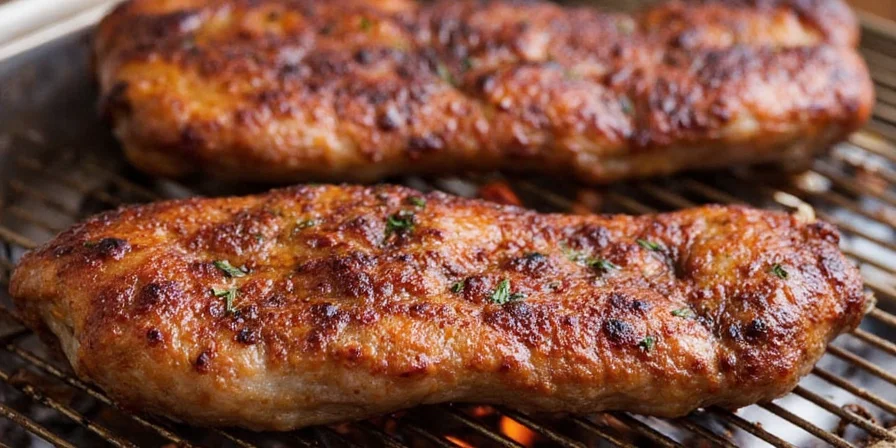For home cooks and grilling enthusiasts seeking authentic Mexican flavors, mastering asada marinade unlocks tender, smoky perfection from even humble cuts. This guide delivers actionable science-backed techniques and creative variations that transform ordinary grilling into extraordinary culinary experiences. Discover precise acid-to-oil ratios, regional adaptation strategies, and flavor chemistry insights unavailable in standard recipe blogs.

What Exactly Is Asada Marinade?
Asada originates from carne asada, translating to 'grilled meat' in Spanish. This vibrant marinade blends citrus acidity, chile complexity, and aromatic herbs to simultaneously tenderize and flavor meat through precise chemical interactions.
Traditionally applied to skirt or flank steak, its cultural significance spans Mexico and border regions where fire-cooking traditions evolved. Unlike generic spice rubs, authentic asada marinade creates textural transformation via enzymatic and acidic reactions.

Classic Ingredients in an Authentic Asada Marinade
The foundation requires carefully balanced components:
- Orange juice or lime juice – provides citric acid for protein denaturation
- Vinegar (white or apple cider) – delivers acetic acid for deeper fiber breakdown
- Garlic – releases allicin compounds when crushed for flavor penetration
- Chilies – chipotle for smokiness, jalapeño for fresh heat, or ancho for fruitiness
- Cumin – contributes earthy thymol compounds that bind to meat proteins
- Mexican oregano – contains carvacrol for complex herbal notes
- Soy sauce or Worcestershire – adds glutamates for umami layering
- Neutral oil (avocado or grapeseed) – carries lipid-soluble flavor molecules
- Salt – enables osmotic moisture exchange within muscle fibers

The Flavor Chemistry Behind Authentic Results
Successful asada marinade leverages three simultaneous reactions: acid-induced protein unfolding (citric/acetic acids), enzymatic tenderization (from citrus enzymes), and osmotic flavor infusion (salt-driven moisture exchange). Crucially, the oil-to-acid ratio must maintain 3:1 to prevent 'cooking' the meat surface while ensuring flavor adhesion. Traditional preparations avoid dairy-based components that curdle under heat, focusing instead on lipid-soluble flavor carriers. This scientific approach explains why bottled juices fail—they lack active enzymes and contain stabilizers that inhibit protein interaction.

| Tips | Description |
|---|---|
| Use Fresh Chilies | Fresh jalapeños or poblanos add crisp heat. For smokiness, try chipotle in adobo. |
| Marinate Overnight | Giving the meat 8–12 hours ensures deeper flavor penetration and better tenderness. |
| Don’t Skip the Acid | Lime or vinegar helps tenderize and brighten up the final dish. |
| Blend Thoroughly | A smooth, well-emulsified marinade coats the meat evenly and maximizes flavor contact. |
| Reserve Some Marinade | Set aside a portion before marinating raw meat to use as a sauce later. |

Spice Level Hacks: Make It Mild, Wild, or Just Right
Adjust heat through controlled capsaicin management:
- Mild Version: Use only chile flesh, remove all seeds/veins, and incorporate bell peppers for sweetness.
- Medium Heat: Jalapeños with 20% seeds retained—capsaicin concentrates in membranes.
- Wild & Smoky: Chipotle in adobo adds dual-layer heat (smoked jalapeño + vinegar infusion).
- Extra Fire: Ghost pepper paste at 0.5% concentration—never exceed 1/8 teaspoon per pound.

Pro-Level Variations You Should Try
These scientifically tested adaptations enhance flavor complexity:
- Asian Twist: Tamari replaces soy sauce for cleaner umami; sesame oil at 5% ratio prevents bitterness.
- Tropical Fusion: Pineapple juice (bromelain enzyme) at 15% max concentration to avoid mushiness.
- Smoky BBQ Style: Smoked paprika (1% concentration) with molasses for Maillard reaction enhancement.
- Herb Lover’s Dream: Cilantro stems (not leaves) blended for stronger flavor without bitterness.
- Umami Bomb: White miso paste (10% ratio) balances fish sauce's pungency while boosting glutamates.

| Meat Type | Why It Works |
|---|---|
| Skirt Steak | Porous texture absorbs flavor quickly. Ideal for quick marination and fast grilling. |
| Flank Steak | Lean and flavorful, benefits from longer marination time for tenderness. |
| Chicken Thighs | Dark meat stays juicy and takes on smoky, spicy flavors beautifully. |
| Pork Shoulder | Marinates overnight for pulled pork tacos with serious depth. |
| Portobello Mushrooms | Vegetarian option! Soaks up the marinade and grills to perfection. |

How Long Should You Marinate Meat?
Optimal duration depends on protein structure:
- Steak: 4–12 hours (collagen-rich cuts need minimum 8 hours)
- Chicken: 2–6 hours (bone-in requires 4+ hours)
- Pork: 6–24 hours (fatty cuts absorb flavors slowly)
- Seafood: 30–90 minutes max (acid denatures proteins rapidly)
Common Mistakes to Avoid with Asada Marinade
Critical errors that undermine results:
- Insufficient salting: Under 1.5% salt by weight prevents osmotic flavor infusion
- Poor oil selection: Olive oil's low smoke point causes bitterness during grilling
- Over-marinating poultry: Exceeding 6 hours makes chicken mushy
- Reusing contaminated marinade: Always reserve pre-contact portion for basting
- Searing too early: Pat meat dry 30 minutes pre-grill for proper crust formation
FAQs: Your Burning Questions Answered
Can I use bottled lime/orange juice?
No. Pasteurization destroys active enzymes crucial for tenderization. Fresh juice provides essential citric acid and enzymatic action that bottled versions lack.
Can I freeze leftover marinade?
Yes, but only unexposed marinade. Freeze in 2-ounce portions for precise future use. Thaw overnight in refrigerator—never refreeze.
Is asada marinade the same as taco seasoning?
No. Asada marinade is wet with acidic components for tenderization; taco seasoning is dry and applied post-cooking for surface flavor.
How do I store unused marinade?
Refrigerate in airtight containers for 72 hours maximum. Discard if oil separation occurs—this indicates ingredient breakdown.
Conclusion: Elevate Your Grilling Through Culinary Science
Authentic asada marinade transcends simple seasoning—it's a precise chemical process that transforms texture and flavor. By understanding the science of acid-protein interactions and regional adaptation principles, home cooks achieve consistent, restaurant-quality results. The true mastery lies not just in following recipes, but in manipulating variables like marination time, acid concentration, and ingredient ratios to match specific cuts and cooking conditions. Apply these principles to unlock new dimensions in every grilled creation.











 浙公网安备
33010002000092号
浙公网安备
33010002000092号 浙B2-20120091-4
浙B2-20120091-4